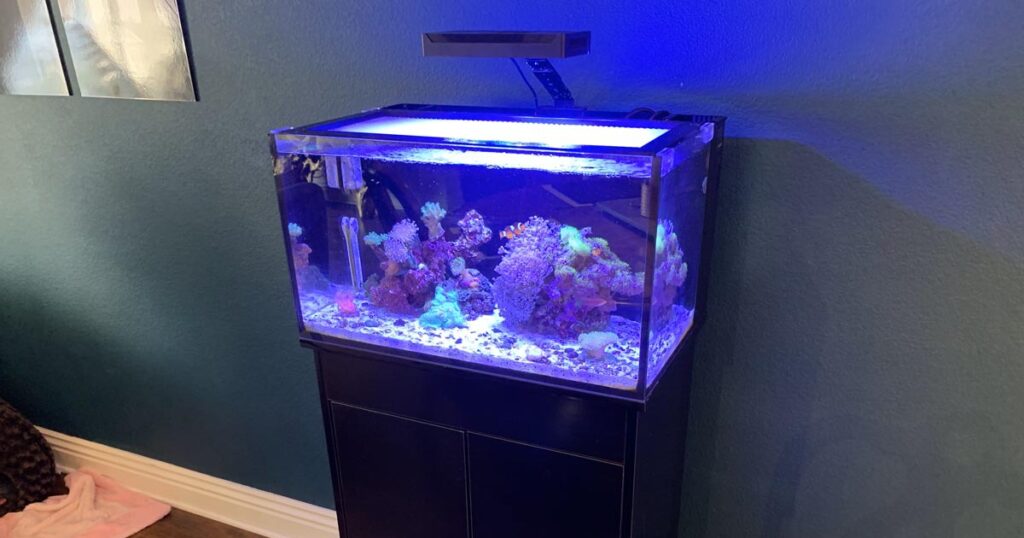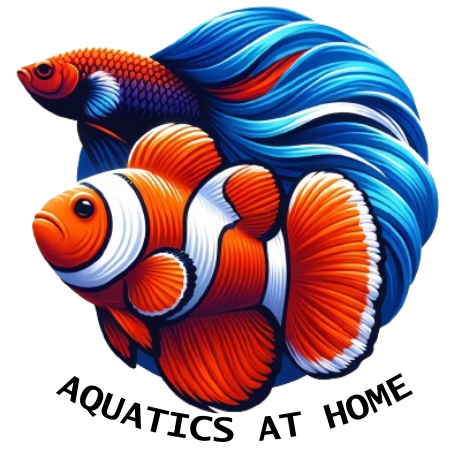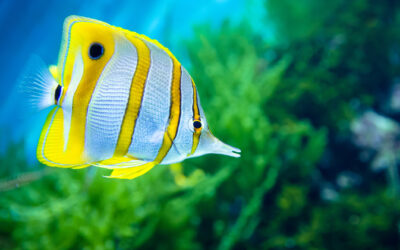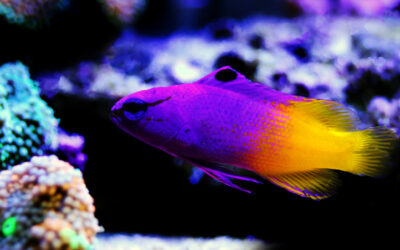Creating a beautiful and thriving saltwater aquarium is a fulfilling experience that requires patience and attention to detail. In this guide, we’ll walk you through setting up a saltwater aquarium, from selecting the right aquarium size and location to adding substrate and decorations.
Choosing the Right Aquarium Size and Location
Keeping an aquarium is a fun and rewarding hobby that can bring a touch of nature into your home. However, setting up an aquarium can be a formidable task, especially if you’re a beginner. When setting up an aquarium, you need to plan around your tank’s size and location in your home. In this article, we’ll take a closer look at these two factors and provide some tips to help you make the right decisions.

Aquarium Size Considerations
When it comes to aquarium size, there are a few things to keep in mind. First and foremost, you need to consider the space you have available. While a larger aquarium provides more space for fish and a more stable environment, it also requires more equipment and maintenance. A smaller aquarium may be easier to maintain, but it can limit the number of fish you can keep.
Another factor to consider is the type of fish you want to keep. Different fish have different space requirements, so you need to choose an aquarium size that can accommodate the fish you want. For example, if you want to keep large fish like cichlids or angelfish, you’ll need a larger aquarium than if you want to keep smaller fish like tetras or guppies.
As a general rule, a good starting point is a 55-gallon tank, which provides adequate space for a variety of fish and invertebrates, while still being manageable for beginners. That being said, larger tanks are always better, so if you can accommodate a larger size, go for it! A bigger aquarium will make for a more stable environment for your fish, and it will also give you more room to decorate and create a beautiful underwater landscape.
Selecting the Ideal Location
Once you’ve chosen the right size aquarium for your needs, the next step is to select the ideal location for it. The location of your aquarium is just as important as its size, as it can have a major impact on the health and well-being of your fish.
One of the most important things to consider when selecting a location is proximity to an electrical outlet. You’ll need to plug in a heater, filter, and other equipment, so you want to make sure the aquarium is close enough to an outlet to avoid having cords running across the room.
Another factor to consider is sunlight. Direct sunlight can increase algae growth, which can be unsightly and harmful to your fish. Therefore, it’s best to place the aquarium away from windows or other areas where it will be exposed to direct sunlight.
It’s also important to avoid placing the aquarium near drafts or heat sources. Drafts can lower the water temperature, which can be harmful to your fish, while heat sources can raise the temperature, making it difficult to maintain a stable environment.
Finally, it’s a good idea to place the aquarium in a low-traffic area, away from household pets and young children can accidentally knock it over. You want to create a peaceful and safe environment for your fish, so they can thrive and live a happy life.
By taking the time to choose the right size and location for your aquarium, you’ll be setting yourself up for success. With the right equipment, maintenance, and care, you can create a beautiful underwater world that will bring you joy and relaxation for years to come.
Essential Saltwater Aquarium Equipment
Setting up a saltwater aquarium has the tendency to be a daunting task, but with the right equipment, it can be a rewarding and enjoyable experience. Here are some essential pieces of equipment that every saltwater aquarium owner should have:
Filtration System
A filtration system is a vital component of a saltwater aquarium. It helps to remove waste and debris from the water, maintaining water quality and a healthy environment for fish and invertebrates. A typical filtration system includes a mechanical filter to remove large particles, a biological filter to break down waste, and a chemical filter to remove impurities.
When choosing a filtration system, think hard about the size of your aquarium and the types of fish and invertebrates you plan to keep. Some species produce more waste than others and require a more powerful filtration system to maintain a healthy environment.
Heater and Thermometer
A reliable heater and thermometer are essential for maintaining a consistent water temperature in your aquarium. Most saltwater fish and invertebrates require a water temperature between 72-78 degrees Fahrenheit. Your heater should have a thermostat and be sized appropriately for your tank.
It’s also important to regularly check the temperature of your aquarium water with a thermometer to ensure that it stays within the appropriate range. Fluctuations in temperature can stress your fish and make them more susceptible to disease.
Lighting System
A lighting system is necessary to promote growth in your corals and other photosynthetic organisms. LED lights are the most popular choice for saltwater aquariums due to their energy efficiency, durability, and customizable features.
When choosing a lighting system, consider the types of corals and other organisms you plan to keep. Different species have different light requirements, so it’s important to choose a lighting system that can provide the appropriate spectrum and intensity of light.
Protein Skimmer
A protein skimmer removes organic waste from the water, preventing it from breaking down and causing harmful bacteria to thrive. It’s a useful tool for maintaining water quality and clarity in your aquarium.
Protein skimmers come in a variety of sizes and styles, so it’s important to choose one that can handle your tank size and the types of fish and invertebrates you plan to keep. Some protein skimmers require regular cleaning and maintenance, so be sure to read the manufacturer’s instructions carefully.
Water Testing Kits
Regular testing of your aquarium water is crucial for maintaining a safe environment for your fish and invertebrates. A water testing kit will help you monitor the levels of ammonia, nitrite, nitrate, and pH in your water, allowing you to make adjustments as needed.
Testing your water regularly can help you identify potential problems before they become serious. Follow the instructions carefully when using a water testing kit to ensure accurate results.
By investing in these essential pieces of equipment, you can create a thriving saltwater aquarium that is both beautiful and healthy for your fish and invertebrates.
Preparing the Saltwater
Mixing Saltwater at Home
When creating saltwater for your aquarium, it’s essential to use the right kind of marine salt to provide the necessary minerals and trace elements that fish and invertebrates need to thrive. You can mix your own saltwater at home using a high-quality marine salt mix and clean, freshwater.
It’s important to follow the instructions on the salt mix to ensure the correct salinity level, which should be between 1.023-1.026 specific gravity. You’ll also need to ensure that the water is properly aerated to remove any chlorine or other chemicals added to the tap water.
Purchasing Pre-mixed Saltwater
If you’re not comfortable mixing your saltwater at home, you can also purchase pre-mixed saltwater from a reputable supplier. This is a convenient option but can be more expensive in the long run.
Testing and Adjusting Salinity Levels
It’s important to regularly test the salinity levels in your aquarium using a hydrometer or refractometer. Salinity levels that are too high or too low can cause problems for your fish and invertebrates.
If your tank’s salinity level is too high, you can add freshwater to bring it down. If it’s too low, you can add marine salt mix to raise it. It’s essential to make adjustments slowly over time to avoid shocking your fish.
Setting Up the Aquarium Substrate and Decorations
Choosing the Right Substrate
Aquarium substrate not only enhances the look of your tank, but it also provides the right environment for beneficial bacteria to grow. There are several options to consider, including live sand, crushed coral, and aragonite sand.
Adding Live Rock and Decorations
Live rock is a great addition to any saltwater aquarium. It’s a natural filtration system that provides a place for beneficial bacteria to grow and fish and invertebrates to hide. It can also contribute to the visual appeal of your aquarium.
When adding decorations, it’s important to ensure they are made from materials safe for your fish and invertebrates. Avoid using decorations with sharp edges or those that can leach harmful chemicals into the water.
Arranging the Aquascape
The aquascape of your aquarium is the arrangement of your live rock, substrate, and decorations. Take the time to carefully plan and arrange these elements to create a visually pleasing and natural-looking environment for your fish and invertebrates.
Consider the needs of the fish and invertebrates you plan to keep when arranging the aquascape. For example, if you have fish that like to hide, provide ample hiding spaces in your aquascape.
Conclusion
Setting up a saltwater aquarium requires planning, patience, and attention to detail. By selecting the right size and location for your aquarium, investing in high-quality equipment, and carefully preparing the saltwater and aquascape, you can create a beautiful and thriving environment for your fish and invertebrates.

About the Author
With decades of experience, James shares his extensive knowledge in aquatics through this website, covering a broad series of topics related to the pond and aquarium hobby. Aiming to guide both beginners and experienced hobbyists alike, his goal is to help educate aquatic enthusiasts for the long-term betterment of the hobby as well as the environment. Learn More >>
Exploring Butterflyfish Species for Marine Aquarium Enthusiasts
Disclaimer: This blog shares my personal experiences, research, and insights as an aquatics hobbyist. While I strive to provide accurate information, please consult a professional or your local fish store for tailored advice on your specific tank setup. Remember,...
Exploring Basslets for Your Marine Aquarium
Disclaimer: This blog shares my personal experiences, research, and insights as an aquatics hobbyist. While I strive to provide accurate information, please consult a professional or your local fish store for tailored advice on your specific tank setup. Remember,...
The Six Line Wrasse: A Comprehensive Guide to Care and Keeping
Disclaimer: This blog shares my personal experiences, research, and insights as an aquatics hobbyist. While I strive to provide accurate information, please consult a professional or your local fish store for tailored advice on your specific tank setup. Remember,...



